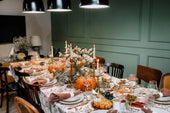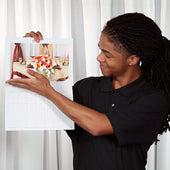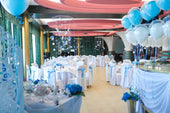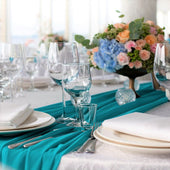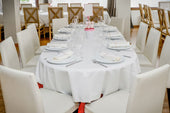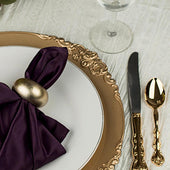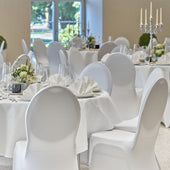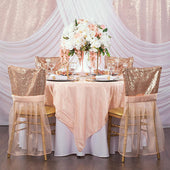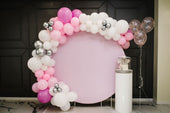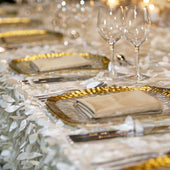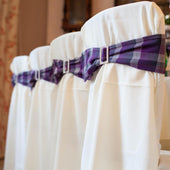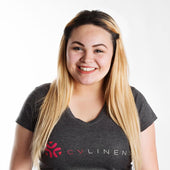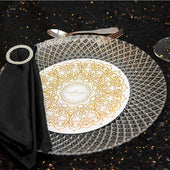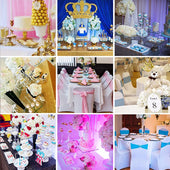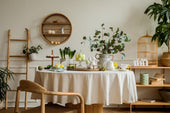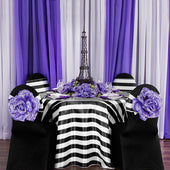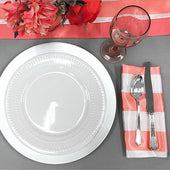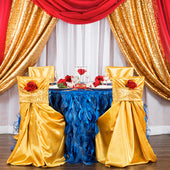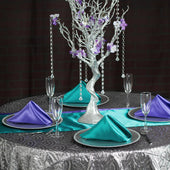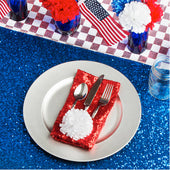Table Runners are a great way to decorate your dining tables for any occasion. This understated yet classic decor piece instantly elevates any table setting.
For this design piece, many decorators opt to buy table runners in bulk. But if you’re into making DIY decor, read this quick guide on how to sew a simple table runner for beginners. This is a creative and budget-friendly option, especially handy for decorating enthusiasts. Dress up your dining experience with the charm of your very own table runner.
Select Materials and Fabrics
1. Fabric Choice
One of the first things you have to decide on when learning how to make a table runner is to decide on the kind of fabric you’ll be using. The most common materials used for runners are cotton, linen, and satin.
These three materials are classic fabrics that are practical, durable, and absorbent. They are also easy to sew and maintain, which helps them to last longer. These materials are affordable options for those working with a tight budget.
You can also opt for more unique options like burlap, cheesecloth, silk, sequin, or chiffon. Sheer material may present a few challenges when trying to sew clean edges. More delicate fabrics like silk may also cost more in price.
2. Color and Pattern
In choosing your fabric, consider the color and pattern that best suits your event’s theme. If you’re throwing a formal event, you can’t go wrong with neutrals like black and white or muted colors.\
For more casual events, you can get creative with pastel colors, patterns, and sequined fabric. For fall table runners, opt for earth tones like terracotta, rust, and deep red, complemented by peach, dusty rose, and champagne. Match the color and pattern to the vibe you’re going for to make table runners that will complement your tablescape.
Emphasize the importance of selecting fabrics that complement the event theme or decor style.
Consider the theme you’re going for at your party to choose the right material for your event. Strike the balance between style and affordability to get the fabric that works for your style and your budget.
Measuring and Cutting Fabric
1. Measure Table Dimensions
Measure the length and width of your tables with a measuring tape. This will determine the desired length and width of your table runners.
2. Compute Desired Dimensions
Determine the length and width of your table runner. As a general rule, table runners should have an overhang of 6-12 inches on both sides. Add at least 12 inches to the length of your table to determine the length of your table runner.
For the width, a typical table runner is 12-18 inches in width. This largely depends on the width of your tables and your aesthetic preference.
3. Adding Seam Allowance
Add a seam allowance of at least one inch on all sides. This will allow you to sew the edges for a clean and polished look.
4. Cut your Fabric
Measure and mark your fabric according to your desired dimensions. Lay your fabric flat and cut along the markings.
Sewing
Fold and sew the edges of your fabric and sew them to create a neat hem. This will ensure that your table runners have no stray fabric or unkempt edges.
1. Hemming the Edges
Press the long edges of the table runner. Fold the edges of the fabric by 3/8 inches towards the wrong side and press. Then turn under 3/8” again and press.
Sew along the side with a 1/4” hem. Repeat the process for the other side.
Repeat the process for the ends of the table runner. You can use a straight stitch, to hem your runner edges.
2. Finishing Touches
Make sure to remove any loose threads to get a clean and elegant look. Iron your table runners one more time to have it ready for use.
By following these steps you can make DIY table runners that have a clean, polished, and professional look.
Adding Embellishments
You can also opt to add embellishments to your table runners for added flair. Learn how to sew a table runner with a border below to impress your guests and add detail to your tablescape.
Trim and Fringe
Add some decorative trimmings or fringes to your table runner for a dash of detail. You can add a lace border or a patterned trim to its side edges. Get creative and experiment with different materials and colors.
Appliqué or Embroidery
You can also add embroidery or applique to your table runners to personalize them. Moreover, you can get digital embroideries of floral patterns or other popular table runner patterns to embellish the edges.
Table runners are a staple in every event decorator’s arsenal to set up a stunning tablescape. They are also a great way to explore your creative and crafty side.
Balance style and affordability by opting for budget-saving items. If you’re making multiple table runners for big events, you can opt to buy 40-yard fabric rolls in bulk to get savings on wholesale prices.
Our Products
40 yds Satin Fabric Roll
Table Runners
Tablecloth





















